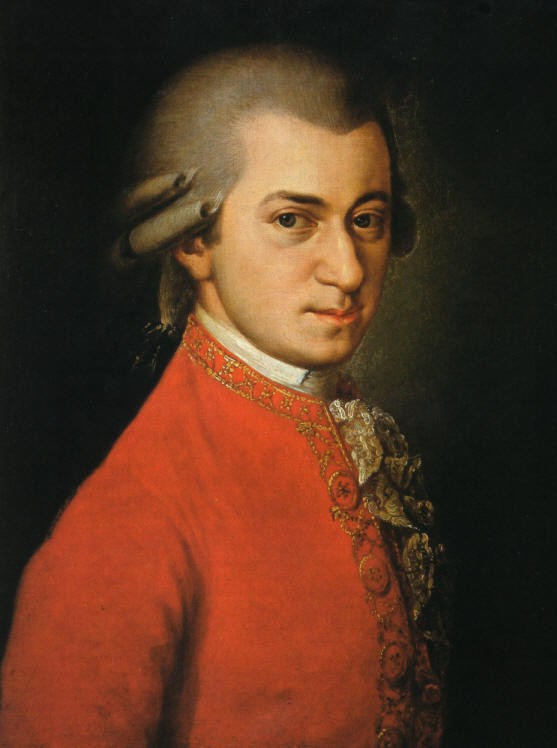Site about Music - Art & Math


 Leopold Mozart was the son of an Augsburg bookbinder. His education was broadly based in the sciences and arts-organ and violin and singing were among his accomplishments. He married Anna Maria Pertl in 1747 and they settled permanently in Salzburg. Leopold was a court musician to the Archbishop-Prince of Salzburg. One of seven children, only Mozart and his sister, Maria Anna,Maria Anna, four years his senior, survived infancy.
Leopold Mozart was the son of an Augsburg bookbinder. His education was broadly based in the sciences and arts-organ and violin and singing were among his accomplishments. He married Anna Maria Pertl in 1747 and they settled permanently in Salzburg. Leopold was a court musician to the Archbishop-Prince of Salzburg. One of seven children, only Mozart and his sister, Maria Anna,Maria Anna, four years his senior, survived infancy.
Their daughter Maria Anna (known as Nannerl), born in 1752, four years before Wolfgang, showed early ability as a keyboard player, but was soon over-shadowed by her brother. Wolfgang was born in a musical home on the 27 January 1756 in Salzburg . Taught by his father, Mozart was way ahead in his education compared to other boys his age. His enthusiasm for music was boundless-he could find his way round a harpsichord at three, played the violin and piano at four. One year later, he composed his very first melodies. Under his father’s teaching Wolfgang’s education advanced far beyond that of boys sent to school. He reveled in it and was never forced or punished.
Leopold took leave of absence from his post, and from 1762, when Wolfgang was six and Nannerl ten, a round of exhibition tours to the courts of Europe began. For next ten years the Mozart family was involved in showing off the genius of the child prodigy, Wolfgang, to the society of the day; he was rapturously received by his audiences. Wolfgang and his sister played piano and violin and were more than successful to tie their audiences to the chairs.
Soon, Wolfgang wrote and published his first composition and when he was nine years old he started writing symphonies. At thirteen, he composed his first opera at the request of an emperor.
In Mannheim, Germany, Mozart met Aloysia Weber, a 16-year-old soprano, and fell in love. He wanted to travel with Aloysia and father but Leopold refused and insisted Mozart went to Paris, with his mother. There he played in the fashionable salons and the Tuileries pleasure gardens. His mother, who had not been well for some time, caught a fever and, as was customary at the time, bled herself in an attempt to relieve it. Left alone in the lodgings, she tragically died, leaving Mozart devastated.
Sacred music occupied Mozart a good deal in the following years; more than a dozen short liturgical pieces plus four masses and two litany settings were written between 1771 and 1773.
At the time…
Mozart played in most of the great courts of Europe, and experienced the high life as well as the low. It was a licentious time, as the old world gave way to the new.
Versailles’ Mistress
Madame de Pompadour, Louis XV’s glamorous mistress from 1745 to 1764, brought a new era of chic to Versailles. Her interest in the decorative arts helped to establish the famous Sevres porcelain, and she cultivated artists and writers, such as Boucher and Voltaire. Famous as much for her elegance as her intellect, Madame de pompadour remained on good terms with the Kong long after his ardor for her had cooled in 1750. She met Mozart at Versailles.
George III bought Buckingham House for his wife Queen Charlotte a year after he came to the throne in 1760. Fourteen of their 15 children were born in what was known as the “Queen’s House”, where Mozart played for the King in 1764. In 1761 the Duke of Buckingham sold the house bearing his name to King George III. It was extensively remodeled and became what is now Buckingham Palace in London.
By age 25 Mozart "had established himself as the finest keyboard player in Vienna," and was recognized as an accomplished composer.
Between January1777 and May 1781, the last years Mozart was to spend under his increasingly callous employer, only a few works heard at Salzburg revealed Mozart’s full powers.
In year 1782, without approval of their families Mozart were married Constanze Weber (younger sister of Aloysia Weber, Mozart’s former lover) in St.Stephen’s Cathedral in Vienna.
Fate granted them only nine years together but they were happy years. It is uncertain where and when Mozart composed the sonata No.11 in A major, K 331;however, Vienna or Salzburg in around 1783 is currently thought to be most likely.
In 1783, their first child died in infancy just before their visit to Salzburg, where Leopold and naneerl received Constanze with cold politeness. We inherit the magnificent C minor Mass which Mozart had vowed to compose for the occasion.